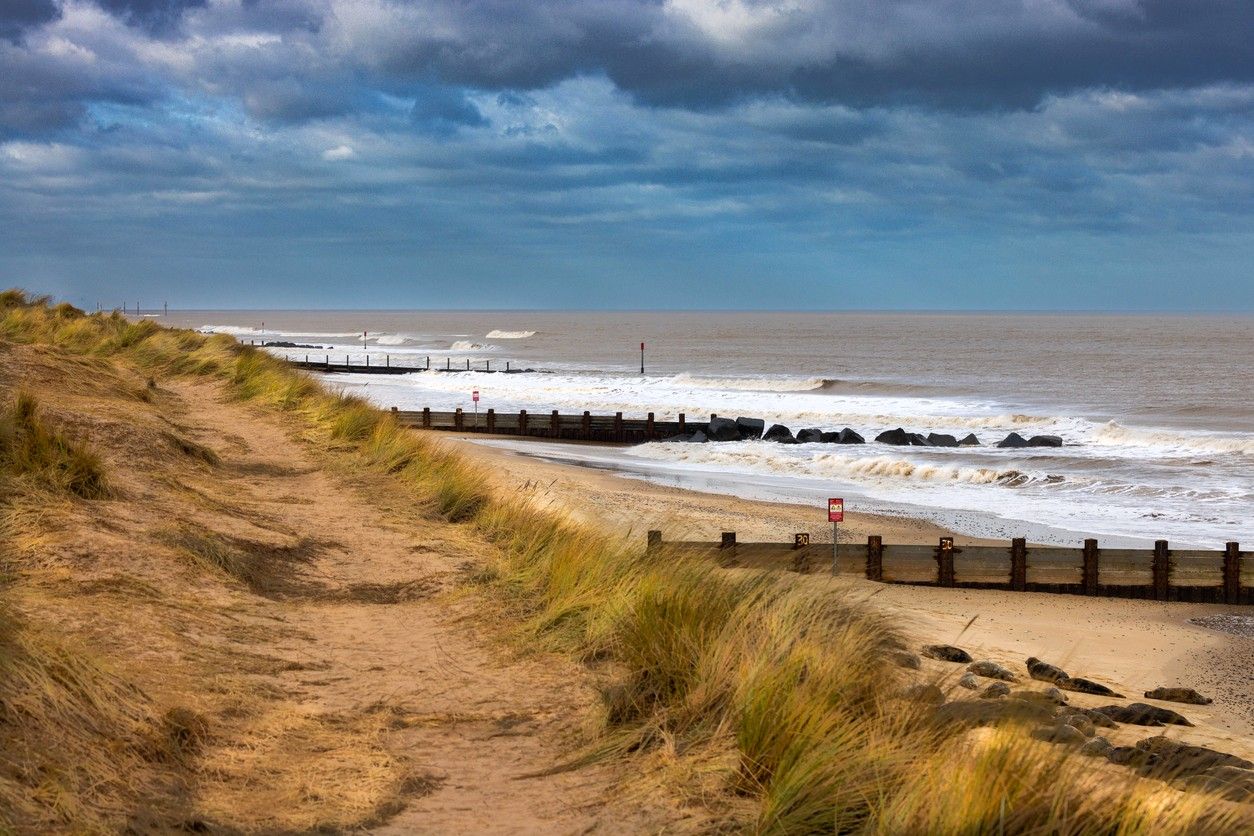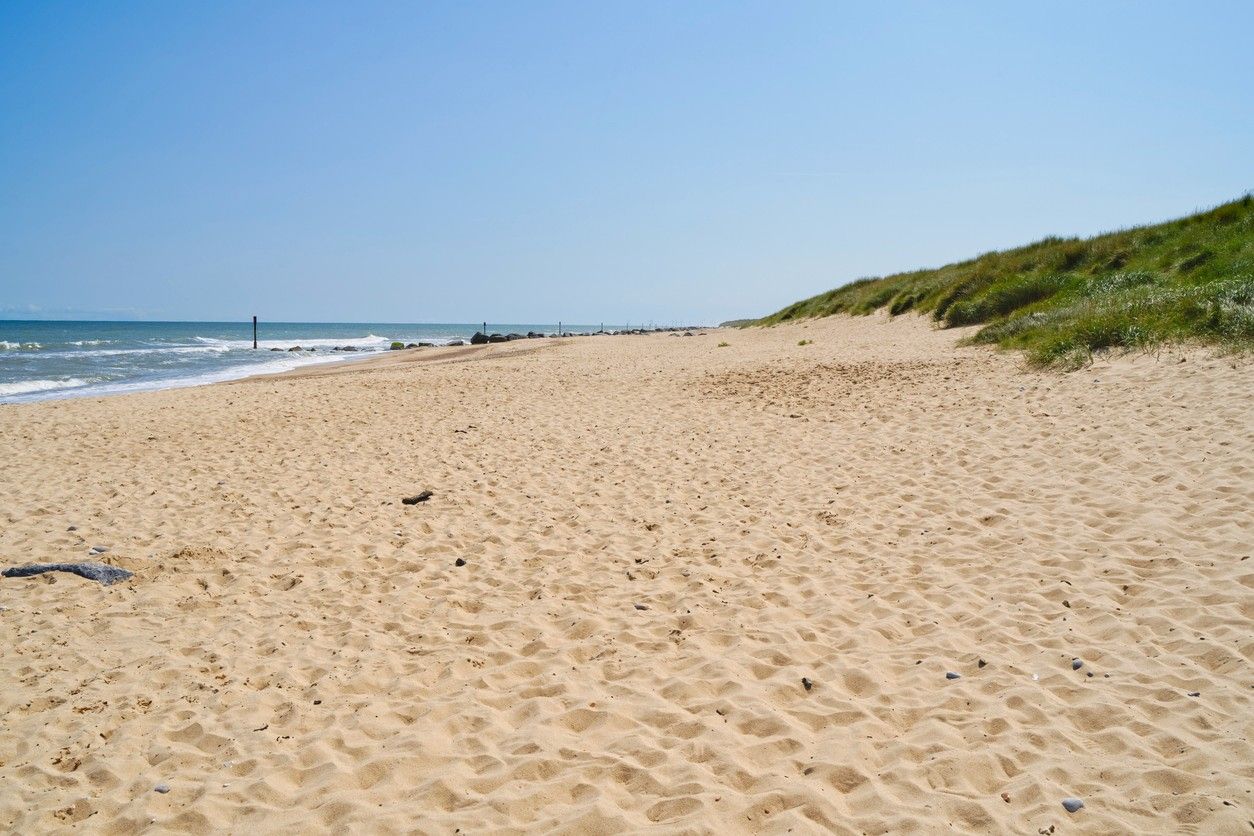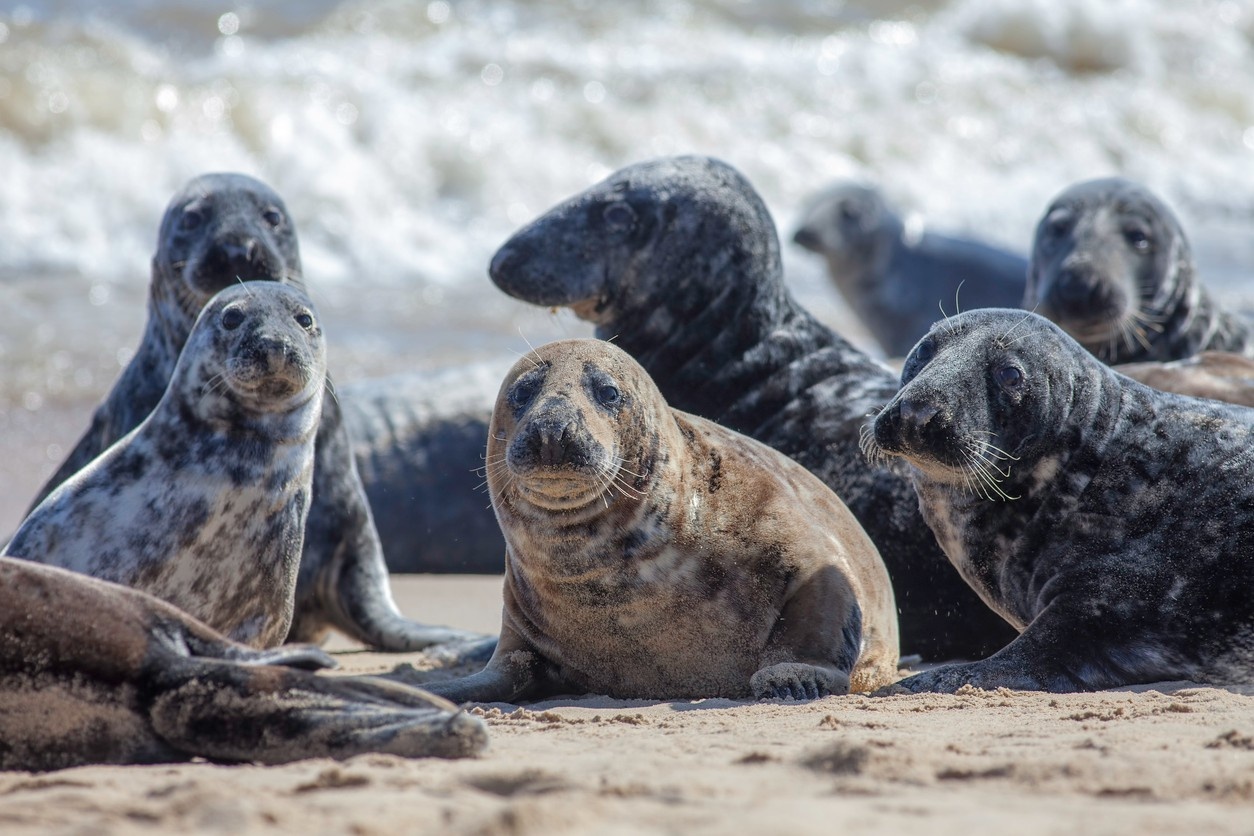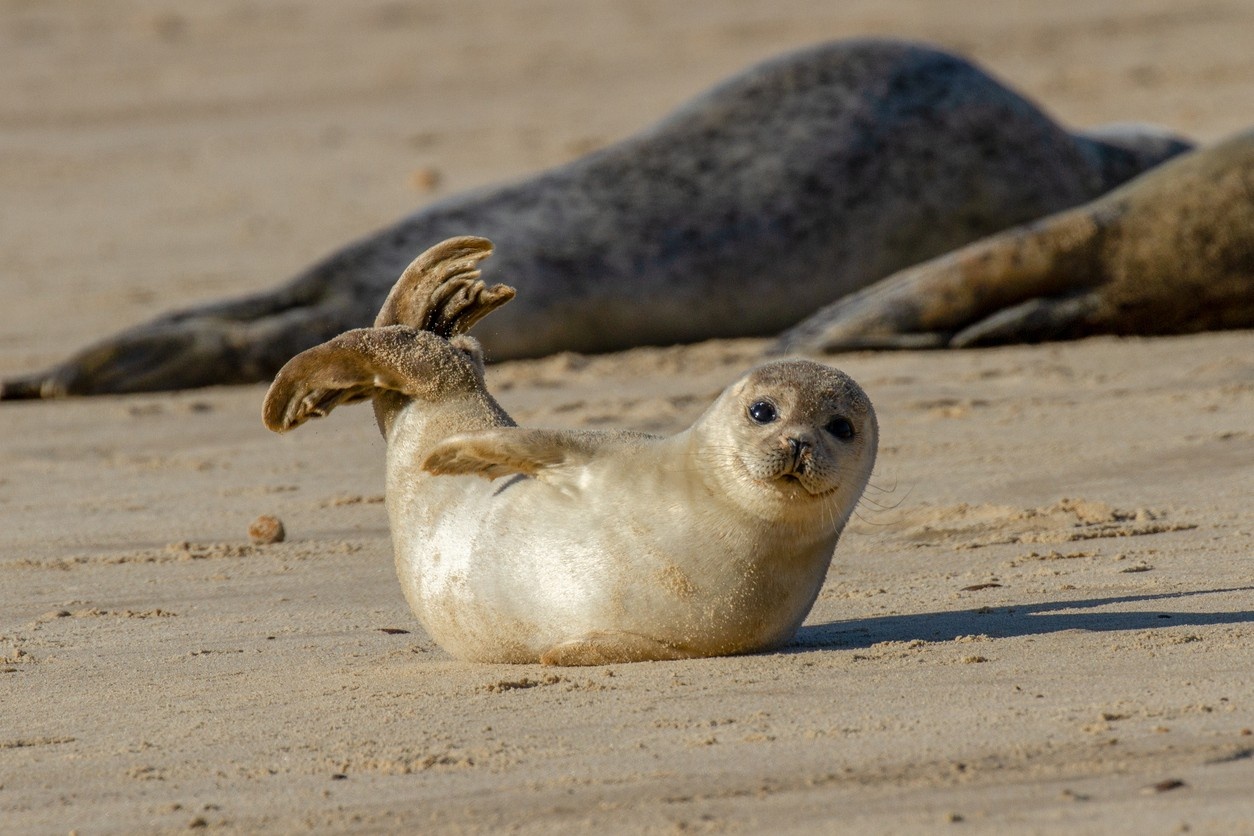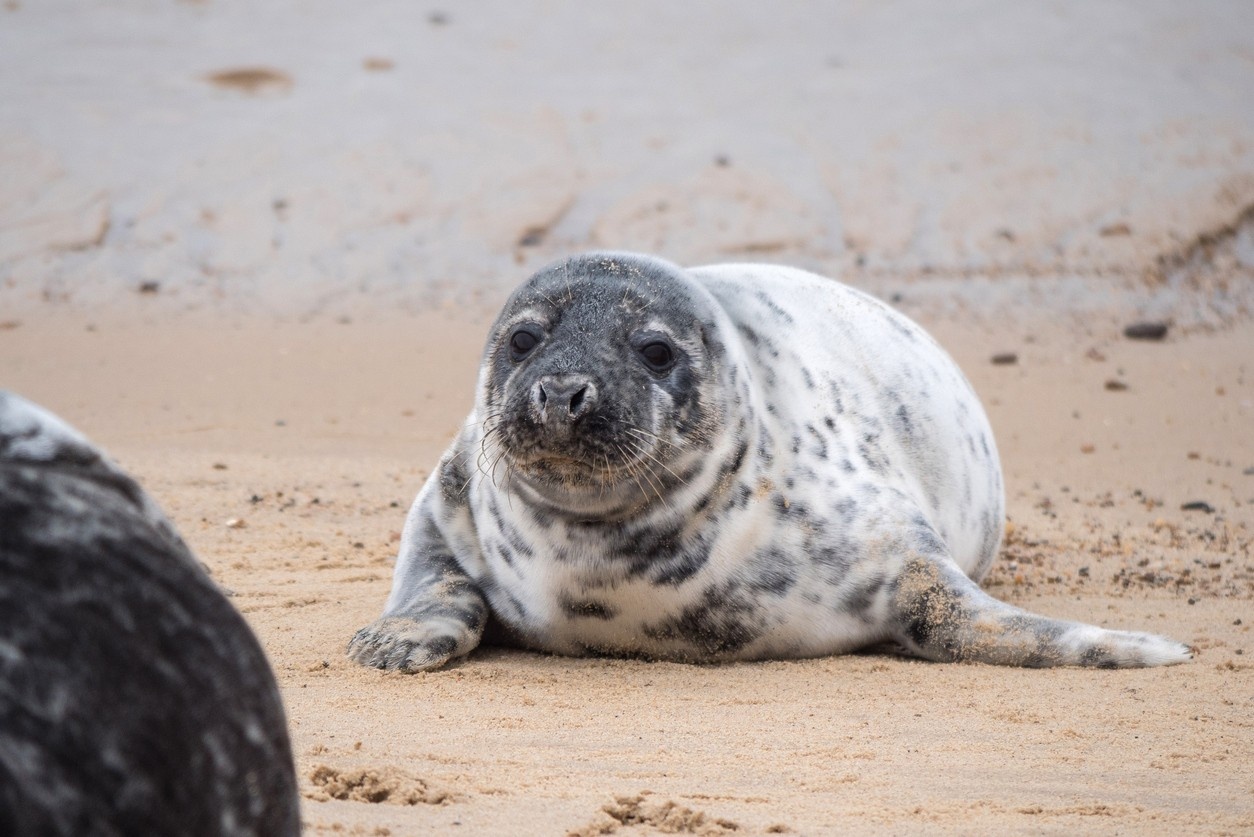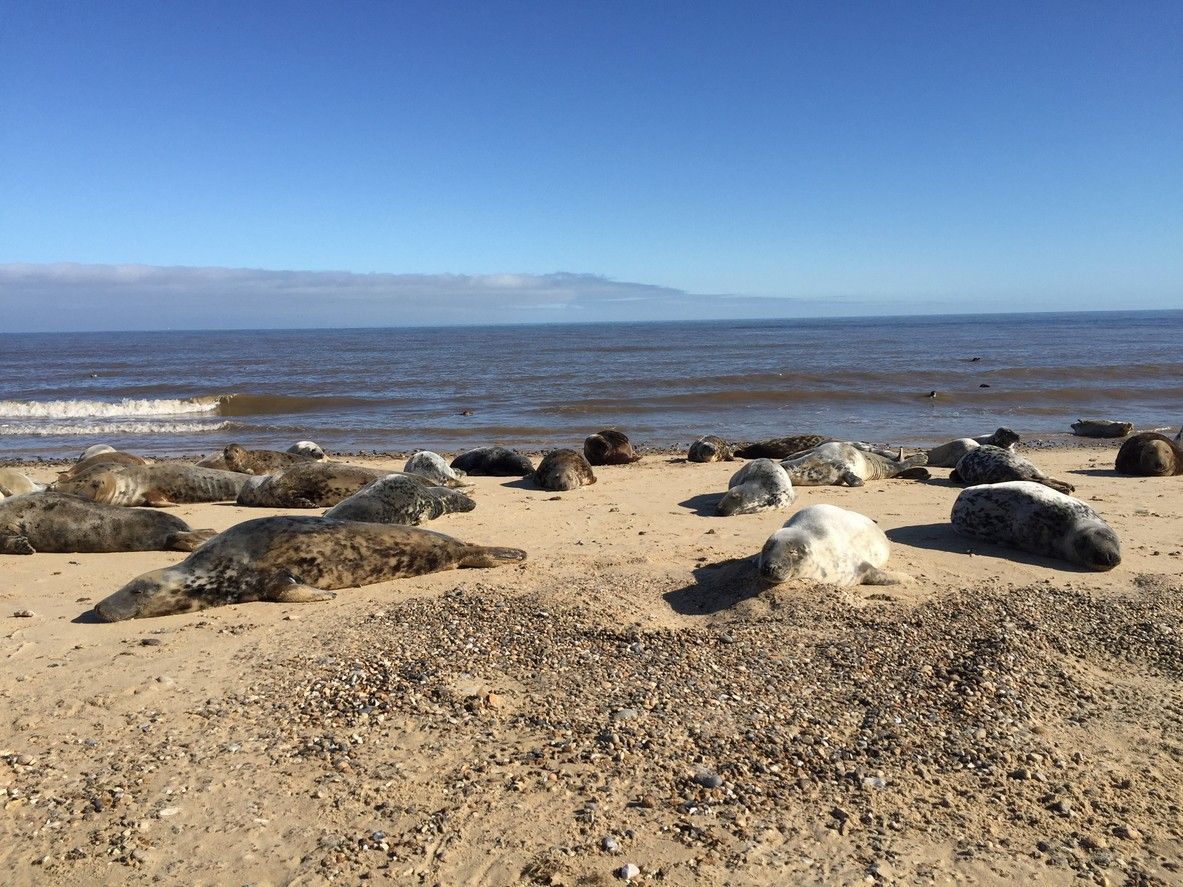If you're looking for an unforgettable wildlife adventure this winter, head to Horsey Beach in Norfolk! From November to January, this unspoilt stretch of coastline becomes a seal paradise as hundreds of adorable fluffy grey seal pups are born on the sand. Seeing these cute babies and their watchful mums up close is simply magical - it's one of the UK's most amazing natural spectacles. Last year over 3,700 pups were born here! The best time to visit is early in the day before it gets busy.
A few tips: wrap up warm as it gets chilly, and keep a respectful distance from the seals (at least 15m). Bring binoculars for a better view. There are some viewing areas on the dunes and a platform with great vantage points. Parking is available at Horsey Gap car park (not National Trust). The walk to the seals from here is about 1 mile on uneven sandy paths, so it can be tricky for pushchairs or wheelchairs. Friendly volunteer seal wardens are on hand to help.
Horsey Beach at a Glance:
- Dog-friendly — Yes, dogs are allowed on Horsey Beach. However, it is best to keep them on a lead and away from the seals, especially during the winter pupping season (November to January)
- Best time to visit — Winter (November to January) is the best time to see the large colony of grey seals that come ashore to give birth on the beach. Hundreds of seals and their pups can be observed during this time. Summer is ideal for a quieter beach day as Horsey never gets too crowded
- Family-friendly — Yes, Horsey Beach is great for families. The soft sand is perfect for children to play on and the shallow water is good for swimming. Seeing the seals in winter is an amazing wildlife experience for all ages
- Surfing conditions — The beach can produce good waves for surfing when there is a swell coming down the North Sea. The gently sloping sand also makes it a safe place to learn and practice water sports like surfing, kayaking and stand-up paddleboarding
- Facilities — Facilities are very limited at Horsey Beach. There are no shops, cafes, toilets or lifeguards directly on the beach. The nearest facilities are in Horsey Village or at Poppylands Tea Room near the main beach car park.
Horsey Beach Car Park and Access
The main access point for Horsey Beach is the car park at Horsey Gap, located just off the A149 coast road. The car park is privately owned and operated and is not a National Trust car park. Parking charges apply at Horsey Gap, with the current rates being £3.50 for up to 2 hours, £5 for up to 4 hours and £7 for the day (as of August 2024). The car park accepts both cash and card payments.
It's important to note that the Horsey Gap car park is for cars only. There is no parking or drop-off near Horsey Gap for coaches, buses, minibuses, motorhomes, campervans, trailers, caravans or horseboxes. The nearest alternative parking for larger vehicles is at Sea Palling, approximately 4 miles away. From the Horsey Gap car park, it is a short walk over the dunes to access the beach. The route is not suitable for wheelchairs or pushchairs due to the soft sand and steps. During the winter seal pupping season, access to parts of the beach may be restricted to prevent disturbance to the seals, with viewing limited to designated areas on the dunes.
An alternative starting point for visiting Horsey Beach is the National Trust's Horsey Windpump, located in the village of Horsey about 1.5 miles inland. From here, a footpath leads across the fields and marshes to the dunes and beach, a walk of around 1.5 miles each way. There are no public toilets or other facilities at Horsey Beach or Horsey Gap car park. The nearest public toilets, shops and cafes are in the villages of Horsey and Somerton, a short drive away.
The Grey Seals of Horsey Beach
The undisputed stars of Horsey Beach are the grey seals that come ashore here in large numbers every winter to give birth and mate. Horsey is home to one of the largest and most accessible grey seal colonies in the UK, with hundreds of pups born on the beach between November and January each year. Grey seals are the larger of the two seal species in British waters. The males can grow up to 2.5m long and weigh over 300kg! Horsey Beach had nearly 4000 seal pups born in the 2022/2023 season, which keeps growing each year. Amazingly, the seals return to the same place each year to give birth, making Horsey an important breeding site. The flat beaches, shallow waters and high dunes offer ideal conditions for the seals to raise their young.
Outside of the pupping season, seals can often be seen at Horsey Beach, either hauled out on the sand or swimming offshore. They are inquisitive animals and will sometimes approach swimmers and surfers in the water, but should never be approached too closely as they are wild animals and can be unpredictable.
Finding the Seals
Once you've parked, follow the signposted paths over the dunes towards the viewing area - it's about a 10-15 minute walk from Horsey Gap car park. As you reach the top of the dunes, you'll be greeted with an incredible view of the seal colony stretched out along the beach. Helpful volunteer seal wardens are on hand to answer questions and point out the best spots to observe the action. There are roped-off viewing areas to prevent disturbance to the seals - please stick to these to keep yourself and the seals safe.
Seal Etiquette
Although they look cute and cuddly, seals are wild animals and can be very protective of their young. For your safety and the welfare of the seals, follow these important guidelines:
- Keep at least 10m away from the seals (the length of a bus!)
- Never get between a seal and her pup
- Don't try to feed, touch or take selfies with the seals
- Keep dogs on a short lead
- Take all litter home with you
Walking and Exploring Horsey Beach
With its wide open spaces and sense of wilderness, Horsey Beach is a wonderful place for a walk at any time of year. A stroll along the beach or through the dunes offers the chance to escape the crowds and immerse yourself in nature.
There are several lovely walking routes to choose from around Horsey Beach:
- Horsey Mere and Dunes Circular Walk —This 5.5 mile (8.8 km) walk takes 2-3 hours, covers mostly flat paths and tracks with a beach section, and starts/ends at Horsey Windpump car park.
- Horsey Gap to Winterton-on-Sea —This 6-mile (9.7 km) round trip walk takes 2-3 hours, covers sandy beach and dunes, and starts/ends at Horsey Gap car park.
- Horsey Windpump to Beach Circular — This 3-mile (4.8 km) walk takes 1-2 hours, covers field paths, tracks, dunes and beach, and starts/ends at Horsey Windpump car park.
- Horsey Village Circular — This 5-mile (8 km) walk takes 2-3 hours, covers country lanes, field paths and beach, and starts/ends at Horsey Village/Horsey Windpump.
Whichever route you choose, come prepared with sturdy footwear as the tracks and dunes can be uneven and sandy. Also, check the tide times and don't get cut off by the incoming tide on the beach sections. Binoculars are great for spotting seals and birdlife. By following these trails you'll get to experience the unique and varied landscapes around Horsey, from the wildlife-rich wetlands to the wild seascapes of the dunes and beach. Just remember to keep your distance from the seals and stick to the paths to avoid disturbing this sensitive environment.
Horsey Windpump and Mere
Just inland from Horsey Beach is the National Trust's Horsey Windpump, a historic drainage mill that once played a vital role in the management of the surrounding marshland. The present structure was built in 1912 on the foundations of the 18th-century Horsey Black Mill. It was used to pump water from the low-lying marshes into the higher-level drainage channels, helping to keep the land dry for agriculture.
The windpump operated until 1943 when it was struck by lightning. It fell into disrepair before being acquired by the National Trust in 1948 from the Buxton family. The Trust has since undertaken several phases of restoration work. The sails were removed in 1956 due to storm damage, with replacements installed in 1962. The Great Storm of 1987 necessitated further repairs before the windpump could reopen to visitors in 1990. In 2016, a major restoration project began to return the windpump to full working order. The cap and sails were reinstated, and in May 2019, the sails turned for the first time since 1943 - a momentous occasion! The restoration was awarded 'Building Conservation Project of the Year 2019' by RICS. Today, visitors to the windpump can climb the 61 steps to the top for panoramic views over the surrounding countryside and out to sea. The balcony is open to the public on certain days of the week, weather permitting.
Next to the windpump is Horsey Mere, a freshwater lake created in the 19th century as a reservoir for the drainage mills. The mere has become an important haven for wildlife, particularly wintering wildfowl like wigeons, teals and shovelers. The mere is surrounded by reedbeds and grazing marshes, which support a variety of breeding birds including marsh harriers, bearded tits and Cetti's warblers. Barn owls can often be spotted hunting over the fields, and if you're very lucky, you may even catch a glimpse of a crane or an otter.
Several waymarked walks start from the Horsey Windpump site, offering the chance to explore this unique wetland landscape. The main circular walk leads you alongside Horsey Mere, through the reedbeds to Brograve Mill, before returning along the beach and dunes - a great way to experience the diversity of habitats in the area. The National Trust has also established a sensory wildlife garden and pond area near the windpump, which is a riot of colour in the summer and attracts many species of bees and butterflies, including the rare swallowtail.
The Village of Horsey
The small village of Horsey is located just inland from the beach and windpump and is worth a visit if you're in the area. Horsey is a civil parish covering an area of 8.49 km2 (3.28 sq mi) within the Broads National Park in the English county of Norfolk. At the 2001 census it had a population of 99 in 40 households, though by the 2011 Census, the population remained less than 100. The village's name means "horse island".
The village is situated at the end of Horsey Mere, a magnificent 120-acre nature reserve and SSSI (Site of Special Scientific Interest). The mere qualifies as a "mere" rather than a "broad" because it is a shallow lake that has formed in a depression in the surrounding marshland. It is an important overwintering site for wildfowl. Horsey parish covers around 2,000 acres and includes a diverse range of habitats like dunes, maritime fen, grazing marsh, and farmland in addition to the mere. The wider area is of great importance for wildlife.
The village itself has a couple of interesting historic buildings. The 14th-century parish church of All Saints is one of 124 existing round-tower churches in Norfolk, a style characteristic of the area. The church has a thatched roof and features a well-preserved medieval hammer-beam roof. Near the church is Horsey House, a former manor house dating back to the early 17th century. It was the seat of the Brograve family and later the Buxton family. The house is not open to the public but can be admired from the outside.
Horsey has a long history of being affected by coastal flooding during storms, with devastating floods recorded in 1287, 1608, 1938 and 1953. On some occasions the sea has broken through and entered the Broads system, rendering the water salty and damaging wildlife. In the 18th century the owner of the Horsey estate, Sir Berney Brograve, tried unsuccessfully to have the sea breaches repaired by an Act of Parliament. Today, upgraded coastal defences protect Horsey from flooding while allowing the natural processes of the dynamic dune system to continue. Coastal change is a key feature of this ever-shifting landscape.
The village also has a pub called the Nelson Head which serves food and drink and is popular with locals and visitors. There are also a couple of small tea rooms near the Horsey Windpump. From the village, quiet lanes and footpaths lead out into the surrounding countryside, with lovely walks possible to the windpump, beach, Brograve Mill and along the Weavers' Way long-distance path. The flat terrain makes it ideal for easy cycling too. So although it may be small, Horsey has a fascinating history and is the perfect base for exploring the unique landscape and wildlife of this special corner of Norfolk. Its unspoilt charm and tranquillity make it a wonderful place to slow down, unwind and connect with nature.
Related Articles

Let us know you agree to cookies
We use marketing, analytical and functional cookies as well as similar technologies to give you the best experience. Third parties, including social media platforms, often place tracking cookies on our site to show you personalised adverts outside of our website.
We store your cookie preferences for two years and you can edit your preferences via ‘manage cookies’ or through the cookie policy at the bottom of every page. For more information, please see our cookie policy.
